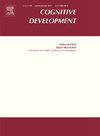好奇心和孩子们对恐龙展览的记忆
IF 1.8
3区 心理学
Q3 PSYCHOLOGY, DEVELOPMENTAL
引用次数: 0
摘要
好奇心可以增强记忆力。在这里,4 - 9岁的儿童在儿童博物馆参观了新奇的三角龙恐龙展览后,他们的好奇心和记忆力被评估了。在参观了一个有三角龙完整骨架化石的展览后,孩子们再次接触了展览中展示的10个恐龙事实,其中一半是突出展示的,一半是次要的事实。大约10天后,通过一项电子调查评估儿童对这些事实的记忆,监护人向他们的孩子大声朗读。监护人还对孩子在参观展览前后对恐龙的好奇心进行了评分。结果表明,更高的好奇心水平与更好的恐龙事实记忆显著相关。事实上,相对于低好奇心,高好奇心预示着对恐龙事实的更好回忆,尤其是对显眼的事实。此外,参观恐龙展览导致对恐龙的好奇心显著增加,这表明博物馆互动对相关信息的好奇心产生了积极影响。总的来说,目前的研究提供了证据,表明博物馆的互动可以提高好奇心,而更高的好奇心可以增强儿童的记忆力。本文章由计算机程序翻译,如有差异,请以英文原文为准。
Curiosity and children’s memory for a dinosaur exhibit
Curiosity can boost memory. Here, curiosity and memory were evaluated within children aged 4–9-years old, after their interaction with a novel triceratops dinosaur exhibit at a children’s museum. After visiting an exhibit with a full skeleton fossil of a triceratops, children were re-exposed to 10 dinosaur facts that had been displayed within the exhibit, half of which were prominently-displayed and half of which were more minor facts. Approximately 10 days later, children’s memory for these facts was evaluated via an electronic survey that guardians read aloud to their children. Guardians also rated their child’s curiosity about dinosaurs both before and after visiting the exhibit. Results indicated that higher curiosity levels were significantly correlated with better dinosaur fact recall. Indeed, high curiosity predicted significantly better recall of dinosaur facts relative to low curiosity, particularly for prominently-displayed facts. Moreover, visiting the dinosaur exhibit resulted in significant increases in curiosity about dinosaurs, demonstrating the positive influence of a museum interaction on curiosity for related information. Overall, the present research provides evidence that a museum interaction can boost curiosity, and higher curiosity enhances memory in children.
求助全文
通过发布文献求助,成功后即可免费获取论文全文。
去求助
来源期刊

Cognitive Development
Multiple-
CiteScore
3.20
自引率
5.60%
发文量
114
期刊介绍:
Cognitive Development contains the very best empirical and theoretical work on the development of perception, memory, language, concepts, thinking, problem solving, metacognition, and social cognition. Criteria for acceptance of articles will be: significance of the work to issues of current interest, substance of the argument, and clarity of expression. For purposes of publication in Cognitive Development, moral and social development will be considered part of cognitive development when they are related to the development of knowledge or thought processes.
 求助内容:
求助内容: 应助结果提醒方式:
应助结果提醒方式:


